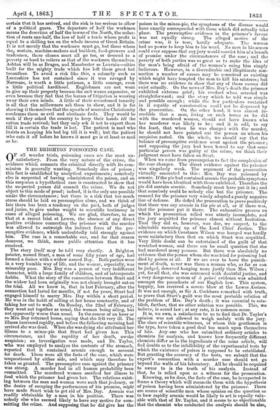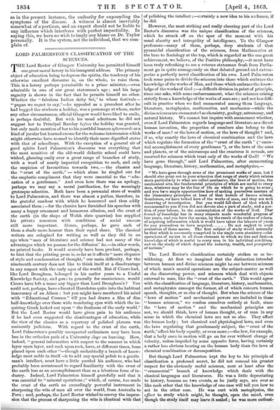THE BRIGHTON POISONING CASE.
OF all murder trials, poisoning cases are the most un- satisfactory. Prom the very nature of the crime, the evidence which connects the criminal directly with its com- mission is generally wanting. Somebody dies of poison ; this fact is established by analytical experiments; somebody else is suspected of having administered the poison, and on this suspicion a hypothetical case is constructed to show that the suspected person did commit the crime. We do not object to this mode of proof; indeed, it is the only one possible unties the circumstances; but there is a risk that too much stress should be laid on presumption alone, and we think of late there has been a tendency on the part, both of judges and juries, to give undue weight to scientific testimony in cases of alleged poisoning. We are glad, therefore, to see that at a recent trial at Lewes, the absence of any direct positive evidence connecting the prisoner with the murder was allowed to outweigh the indirect force of the pre- sumptive evidence, which undoubtedly told strongly against him. The case is a remarkable one, and for that reason deserves, we think, more public attention than it has received.
The story itself may be told very shortly. A Brighton painter, named Sturt, a man of some fifty years of age, had formed a liaison with a widow named Day. Both parties were in a very humble way of life, and the woman, especially, was miserably poor. Mrs. Day was a person of very indifferent character, with a large family of children, and of intemperate .habits. What the story of the connection between Sturt and the widow had been originally was not clearly brought out on the trial. All we know is, that in last February, after the connection had lasted for months, if not for years, Sturt had engaged himself to marry Mrs. Day within a short period. He was in the habit of calling at her house constantly, and of taking her out to walk. On Sunday, the 22nd of February, they went out together as usual, the woman being ailing, but not apparently worse than usual. In the course of an hour or so Mrs. Day returned home, saying that she felt very ill. The illness increased rapidly, and before the following morning bad 'arrived she was dead. When she was dying she attributed her illness to a mince-pie that Sturt had given her. This circumstance, and the rapidity of her death, awoke suspicion ; an investigation was made, and Dr. Taylor, who was employed to analyze the contents of the stomach, reported that it contained arsenic enough to account for death. These were all the facts of the case, which were unquestioned by either side, and which may therefore be taken as granted. The presumptive case against the prisoner was strong. A murder had in all human probability been committed. The murdered woman ascribed her illness to food which the prisoner had given her. The relations exist- ing between the man and woman were such that jealousy, or the desire of escaping the performance of his promise, might have made Sturt wish to get rid of Mrs. Day. Arsenic was readily obtainable by a man in his position. There was nobody else who seemed likely to have any motive for com- mitting the crime. And supposing that he did give her the poison in the mince-pie, the symptoms of the disease would have exactly corresponded with those which did actually take place. The presumptive evidence in the prisoner's favour was not equally strong. The alleged motive of the crime was, it is true, hardly adequate. The woman had no power to keep him to his word. No man in his senses could ever suppose that any jury would convict him of a breach. of promise under the circumstances of the ease ; and the poverty of both parties was so great as to make the idea of the man's being afraid of the woman's suing him simply ludicrous. However, in a discreditable and illegitimate con- nection a number of causes may be conceived as existing which might have tempted the man to kill his mistress ; but there was no evidence to show that any of these causes did exist actually. On the news of Mrs. Day's death the prisoner exhibited extreme grief; his conduct when arrested was straightforward; and the story which he told was simple and possible enough ; while the few particulars contained in it capable of corroboration could not be disproved by the prosecution. On the other hand, it was almost in- credible that a man, living on such terms as he did with the murdered woman, should not have known who her murderer was likely to be ; and it is odd, to say the least, that when he was charged with the murder, he should not have pointed out the person on whom his suspicion rested. On the whole, we should say that the balance of presumptive evidence went against the prisoner ; and supposing the jury had been bound to say that some particular person was guilty of the crime, we think their judgment must have fallen on Start.
When we came from presumption to fact the complexion of the case changes. The direct evidence against the prisoner was singularly weak. The argument of the prosecution virtually amounted to this : Mrs. Day was poisoned by arsenic. If the pie had contained arsenic the probable symptoms would have been identical with those exhibited. Therefore the pie did contain arsenic. Somebody must have put it in ; and that somebody could be nobody else but the prisoner. The counsel for the prisoner very wisely adopted a purely negative line of defence. Ho defied the prosecution to prove positively that there was any arsenic in the pie at all, or if there was, that the prisoner put it there. The exhaustive process on which the prosecution relied was utterly incomplete, and the jury acquitted the prisoner almost without hesitation. That they did so, however, was due, we suspect, to the admirable summing up of the Lord Chief Justice. The evidence on which Constance Wilson was hanged was hardly more satisfactory than that on which Stud was acquitted. Very little doubt can be entertained of the guilt of that wretched woman, and there can be small question that she had murdered many persons. But there was absolutely no evidence that the person whom she was tried for poisoning had died by poison at all. If we are ever to have the punish- ment of death, never was there a woman who, as far as can be judged, deserved hanging more justly than Mrs. Wilson ; yet, for all that, she was sentenced with doubtful justice, and a very dangerous system of a priori evidence was admitted amongst the precedents of our English law. This system, happily, has received a severe blow at the Lewes Assizes. It was not enough, as Sir A. Cockburn remarked with truth, to prove that Sturt's guilt was the most probable solution of the problem of Mrs. Day's death ; it was essential to esta- blish, further, that no other solution was possible. This, we believe, is sound law ; at any rate, it is common sense.
It is, we own, a satisfaction to us to find that Dr. Taylor's opinion was not allowed to weigh unduly with the jury. The class of scientific witnesses, of whom this gentleman. is the type, have taken a good deal too much upon themselves of lute. Any. one who has submitted ordinary articles to chemists for analysis, and knows how frequently different chemists differ as to the ingredients of the same article, will feel doubts as to the infallibility of the experimental tests by which the existence of poison is supposed to be established. But granting the accuracy of the tests, we submit that the expert's connection with a murder case should not go beyond the walls of his laboratory. All he should be required to swear to is the truth of his analysis. Instead of that, he is relied upon as a witness for the prosecution.
Knowing, as he does, the facts of the case, he is expected to frame a theory which will reconcile them with the hypothesis of poison having been administered by the prisoner. There are scores of scientific men whose opinion on the question as to how rapidly arsenic would be likely to act is equally valu- able with that of Dr. Taylor, and it seems to us objectionable that the chemist who conducted the analysis should be also,
as in the present instance, the authority for expounding the symptoms of the disease. A witness is almost inevitably somewhat of a partizan, and an expert should not be liable to any influence which interferes with perfect impartiality. In saying this, we have no wish to imply any blame on Dr. Taylor personally. It is the system, not the individual, that we com- plain of.































 Previous page
Previous page